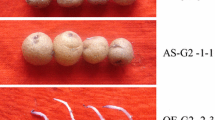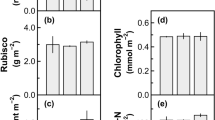Abstract
The introduction of an antisense DNA into transgenic potato (Solanum tuberosum L.) plants decreased the expression of the chloroplast triose-phosphate translocator and lowered its activity by 20–30%. With plants propagated from tubers, the effect of the transformation on photosynthetic metabolism was analysed by measuring photosynthesis, the formation of leaf starch, and the total and subcellular metabolite contents in leaves. Although the transformants, in contrast to those propagated from cell cultures, did not differ from the wild-type plants in respect to rates of photosynthesis, plant appearance, growth and tuber production, their photosynthetic metabolism was found to be severely affected. The results show that the decrease in activity of the triose-phosphate translocator in the transformants caused a fourfold increase in the level of 3-phosphoglycerate and a corresponding decrease in inorganic phosphate in the stromal compartment, resulting in a large increase in the synthesis of starch. Whereas during a 12-h day period wild-type plants deposited 43% of their CO2 assimilate into starch, this value rose to 61–89% in the transformants. In contrast to the wild-type plants, where the rate of assimilate export from the leaves during the night period was about 75% of that during the day, the export rate from leaves of transformants appeared to be much higher during the night than during the day. As the mobilisation of starch occurs in part hydrolytically, resulting in the formation of glucose, the triose-phosphate translocator loses its exclusive function in the export of carbohydrates from the chloroplasts when the photoassimilates are temporarily deposited as starch. It appears that by directing the CO2 assimilates mainly into starch, the transformants compensate for the deficiency in triose-phosphate translocator activity in such a way that the productivity of the plants is not affected by the transformation.
Similar content being viewed by others
Abbreviations
- Chl:
-
chlorophyll
- DHAP:
-
dihydroxyacetone phosphate
- 3-PGA:
-
3-phosphoglycerate
- Rubisco:
-
ribulose,1,5-bisphosphate carboxylase/oxygenase
- RuBP:
-
ribulose-1,5-bisphosphate
- trioseP:
-
triose phosphate
- WT:
-
wild type
References
Badger, M.R., Lorimer, G.H. (1981) Interaction of sugar phosphates with the catalytic site of ribulose-1,5-bisphosphate carboxylase. Biochemistry 20, 2219–2225
Fliege, R., Flügge, U.I., Werdan, K., Heldt, H.W. (1978) Specific transport of inorganic phosphate, 3-phosphoglycerate and triosephosphates across the inner membrane of the envelope in spinach chloroplasts. Biochim. Biophys. Acta 502, 232–247
Flügge, U.I., Heldt, H.W. (1981) The phosphate translocator of the chloroplast envelope. Isolation of the carrier protein and reconstitution of transport. Biochim. Biophys. Acta 638, 296–304
Flügge, U.I., Gerber, J., Heldt, H.W. (1983) Regulation of the reconstituted chloroplast phosphate translocator by an H+ gradient. Biochim. Biophys. Acta 725, 229–237
Flügge, U.I., Fischer, K., Gross, A., Sebald, W., Lottspeich, F., Eckerskorn, C. (1989) The triose phosphate-3-phosphoglyceratephosphate translocator from spinach chloroplasts: Nucleotide sequence of a full-length cDNA clone and import of the in vitro synthesised precursor protein into chloroplasts. EMBO J. 8, 39–46
Fondy, B.R., Geiger, D.R. (1982) Diurnal pattern of translocation and carbohydrate metabolism in source leaves of Beta vulgaris L. Plant Physiol. 70, 671–676
Gerhardt, R., Heldt, H.W. (1984) Measurement of subcellular metabolite levels in leaves by fractionation of freeze-stopped material in non aqueous media. Plant Physiol. 75, 542–547
Gerhardt, R., Stitt, M., Heldt, H.W. (1987) Subcellular metabolite levels in spinach leaves. Regulation of sucrose synthesis during diurnal alterations in photosynthetic partitioning. Plant Physiol. 83, 399–407
Heldt, H.W., Rapley, L. (1970) Specific transport of inorganic phosphate, 3-phosphoglycerate and dihydroxyacetone phosphate, and of dicarboxylates across the inner membrane of spinach chloroplasts. FEBS Lett. 10, 143–148
Heldt, H.W., Chon, C.J., Maronde, D., Herold, A., Stancovic, Z.S., Walker, D.A., Kraminer, A., Kirk, M.R., Heber, U. (1977) Role of orthophosphate and other factors in the regulation of starch formation in leaves and isolated chloroplasts. Plant Physiol. 59, 1146–1155
Heldt, H.W., Chon, C.J., Lorimer, G.H. (1978) Phosphate requirement for the light activation of ribulose-1,5-bisphosphate carboxylase in intact spinach chloroplasts. FEBS Lett. 92, 234–240
Hendrix, D.L., Huber, S.C. (1986) Diurnal fluctuations in cotton leaf carbon export, carbohydrate content, and sucrose synthesising enzymes. Plant Physiol. 81, 584–586
Herold, A., Leegood, R.C., McNeil, P.H., Robinson, S.P. (1981) Accumulation of maltose during photosynthesis in protoplasts isolated from spinach leaves treated with mannose. Plant Physiol. 67, 85–88
Kalt-Torres, W., Kerr, P.S., Usuda, H., Huber, S.C. (1987) Diurnal changes in maize leaf photosynthesis. I Carbon exchange rate, assimilate export rate, and enzyme activities. Plant Physiol. 83, 283–288
Preiss, J., Levi, C. (1980) Starch biosynthesis and degradation. In: The biochemistry of plants, vol. 3, pp. 371–423, Stumpf, P.K., Conn, E.E., eds. Academic Press, New York
Riens, B., Lohaus, G., Heineke, D., Heldt, H.W. (1991) Amino acid and sucrose determined in the cytosolic, chloroplastic, and vacuolar compartments and in the phloem sap of spinach leaves. Plant Physiol. 97, 227–233
Riens, B., Lohaus, G., Winter, H., Heldt, H.W. (1994) Production and utilization of assimilates in leaves of spinach (Spinacia oleracea) and barley (Hordeum vulgare). Planta, in press
Riesmeier, J.W., Flügge, U.I., Schulz, B., Heineke, D., Heldt, H.W., Willmitzer, L., Frommer, W.B. (1993) Antisense repression of the chloroplast triose phosphate translocator affects carbon partioning in transgenic potato plants. Proc. Natl. Acad. Sci. USA 90, 6160–6164
Schäfer, G., Heber, U., Heldt, H.W. (1977) Glucose transport into spinach chloroplasts. Plant Physiol. 60, 286–289
Schulz, B., Frommer, W.B., Flügge, U.I., Hummel, S., Fischer, K., Willmitzer, L. (1993) Expression of the triose phosphate translocator gene from potato is light dependent and restricted to green tissues. Mol. Gen. Genet. 238, 357–361
Sowokinos, J.R. (1976) Pyrophosphorylases in Solanum tuberosum. I. Changes in ADP-glucose and UDP-glucose pyrophosphorylase activities associated with starch biosynthesis during tuberization, maturation, and storage of potatoes. Plant Physiol. 68, 924–929
Stitt, M. (1986) Limitation of photosynthesis by carbon metabolism. I Evidence for excess electron transport capacity in leaves carrying out photosynthesis in saturating light and CO2. Plant Physiol. 81, 1115–1122
Stitt, M., Große, H. (1988) Interactions between sucrose synthesis and CO2 fixation. I Secondary kinetics during photosynthetic induction are related to a delayed activation of sucrose synthesis. J. Plant Physiol. 133, 129–137
Stitt, M., Heldt, H.W. (1981) Physiological rates of starch breakdown in isolated intact spinach chloroplasts. Plant Physiol. 68, 755–761
Stitt, M., Lilley, R.McC., Gerhardt, R., Heldt, H.W. (1989) Metabolite levels in specific cells and subcellular compartments of plant leaves. Methods Enzymol. 174, 518–552
Walker, D.A., Sivak, M.N., Prinsley, R.T., Cheesbrough, J.K. (1983) Simultaneous measurement of oscillations in oxygen evolution and chlorophyll a fluorescence in leaf pieces. Plant Physiol. 73, 542–549
Willey, D.L., Fischer, K., Wachter, E., Link, T.A., Flügge, U.I. (1991) Molecular cloning and structural analysis of the phosphate translocator from pea chloroplasts and its comparison to the spinach phosphate translocator. Planta 183, 451–461
Winter, H., Lohaus, G., Heldt, H.W. (1992) Phloem transport of amino acids in relation to their cytosolic levels in barley leaves. Plant Physiol. 99, 996–1004
Woodrow, J.E., Berry, J.A. (1988) Enzymatic regulation of photosynthetic CO2 fixation in C3 plants. Annu. Rev. Plant Physiol. Plant Mol. Biol. 39, 533–594
Author information
Authors and Affiliations
Additional information
The able technical assistance of Mrs. K. Wildenberger and Mrs. A. Großpietsch is gratefully acknowledged. This work has been supported by the Bundesminister für Forschung und Technologie.
Rights and permissions
About this article
Cite this article
Heineke, D., Kruse, A., Flügge, UI. et al. Effect of antisense repression of the chloroplast triose-phosphate translocator on photosynthetic metabolism in transgenic potato plants. Planta 193, 174–180 (1994). https://doi.org/10.1007/BF00192527
Received:
Accepted:
Issue Date:
DOI: https://doi.org/10.1007/BF00192527




